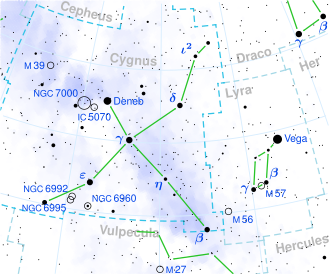| Observation data Epoch J2000.0 Equinox J2000.0 | |
|---|---|
| Constellation | Cygnus [1] |
| A | |
| Right ascension | 20h 03m 37.405s [2] |
| Declination | +29° 53′ 48.49″ [2] |
| Apparent magnitude (V) | +5.73 [3] |
| B | |
| Right ascension | 20h 03m 26.581s [4] |
| Declination | +29° 51′ 59.53″ [4] |
| Apparent magnitude (V) | +14.4 [5] |
| Characteristics | |
| A | |
| Evolutionary stage | main sequence [2] [6] |
| Spectral type | G6IV [3] |
| B | |
| Evolutionary stage | main sequence [7] |
| Spectral type | M4.5V [8] |
| Astrometry | |
| A | |
| Radial velocity (Rv) | −45.34±0.12 [2] km/s |
| Proper motion (μ) | RA: +683.196 mas/yr [2] Dec.: −525.501 mas/yr [2] |
| Parallax (π) | 62.4865±0.34 mas [2] |
| Distance | 52.2 ± 0.3 ly (16.00 ± 0.09 pc) |
| Absolute magnitude (MV) | +4.73 [1] |
| B | |
| Radial velocity (Rv) | −44.02±0.40 [4] km/s |
| Proper motion (μ) | RA: +681.116 mas/yr [4] Dec.: −525.863 mas/yr [4] |
| Parallax (π) | 62.5269±0.0225 mas [4] |
| Distance | 52.16 ± 0.02 ly (15.993 ± 0.006 pc) |
| Absolute magnitude (MV) | +13.3 [5] |
| Details | |
| A | |
| Mass | 0.991+0.039 −0.040 [9] M☉ |
| Radius | 1.142±0.009 [10] R☉ |
| Luminosity | 1.114±0.007 [10] L☉ |
| Surface gravity (log g) | 4.292±0.012 [10] cgs |
| Temperature | 5,557±22 [10] K |
| Metallicity [Fe/H] | 0.17±0.04 [10] dex |
| Rotation | 40 [11] days |
| Rotational velocity (v sin i) | 2.8 [11] km/s |
| Age | 4.79 [3] Gyr |
| B | |
| Mass | 0.21 [12] M☉ |
| Radius | 0.24 [12] R☉ |
| Luminosity | 0.0044 [13] L☉ |
| Surface gravity (log g) | 4.84 [14] cgs |
| Temperature | 3.169 [12] K |
| Metallicity [Fe/H] | 0.06 [7] dex |
| Rotational velocity (v sin i) | 7.1 [14] km/s |
| Age | 2.5 [7] Gyr |
| Other designations | |
| GJ 777 | |
| A: BD+29°3872, HD 190360, HIP 98767, HR 7670, LHS 3510 | |
| B: G 125-55, LHS 3509 | |
| Database references | |
| SIMBAD | A |
| B | |
| Exoplanet Archive | data |
| ARICNS | data |
| data2 | |
Gliese 777, also known as HD 190360, is a binary star system approximately 52 light-years away in the constellation of Cygnus. The system is made up of two stars and possibly a third. Three exoplanets are known to orbit the primary star.

